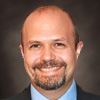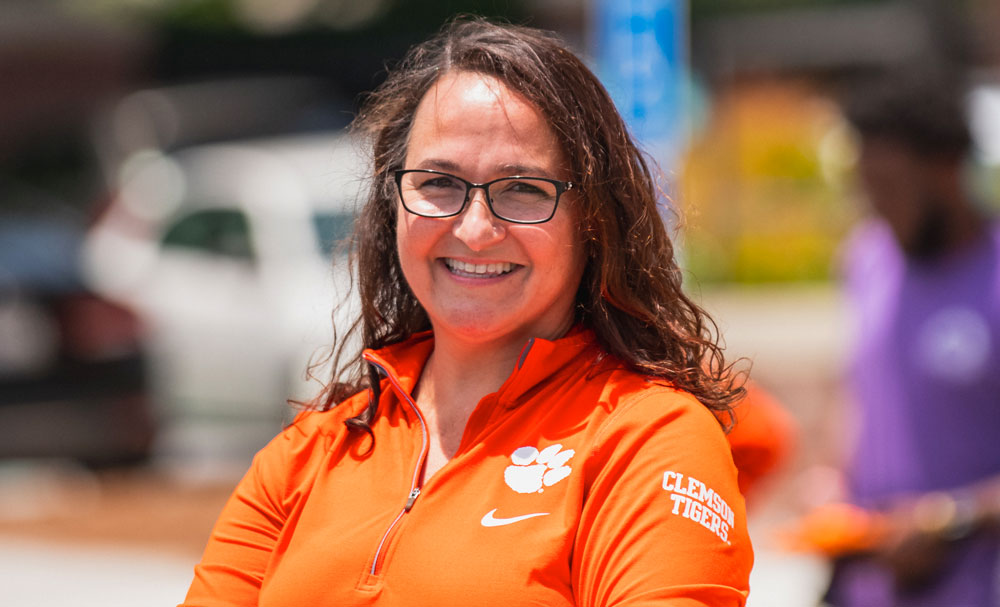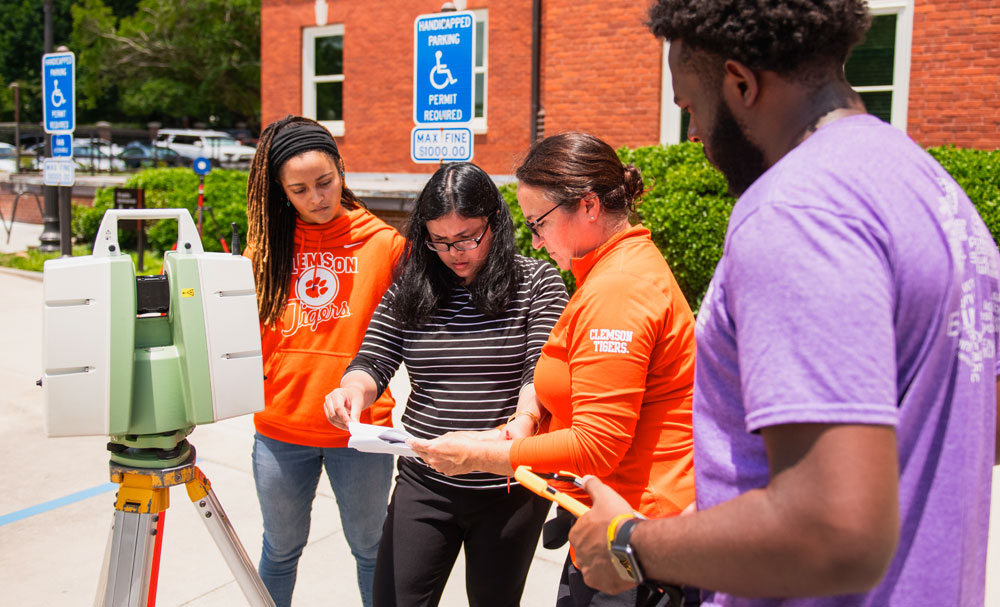BUILDING A RAMP TO EQUITY, DIVERSITY & INCLUSION
BUILDING A RAMP TO EQUITY, DIVERSITY & INCLUSION
BUILDING A RAMP TO EQUITY, DIVERSITY & INCLUSION

Civil engineers are teaming up with facilities and planning officials to make campus more accessible for individuals with mobility impairments.
Jennifer Ogle leaned in close to look at a lidar scanner perched atop a tripod on a sun-drenched sidewalk at Clemson University. She and two Ph.D. students were measuring slope grade on wheelchair accessible parking spaces in the adjoining lot. Anything more than 2%, she said, would be too steep.
Ogle and her students were working behind Sikes Hall on a sweltering afternoon as part of their in-depth study into what areas of campus need upgrades to comply with the American with Disabilities Act and proposed rulemaking. They have used high-tech equipment, such as drones and lidar scanners, along with old-school tools, such as levels and tape measures, to examine the entire classroom district of campus, an area that encompasses more than 35 miles of sidewalk.
For Ogle, it was the result of a vow she made to herself more than two decades ago to never let a student graduate without knowing about the law.

Jennifer Ogle, Professor and Associate Chair of Civil Engineering
Clemson officials are using the study, first started in 2019, as a guide to make campus easier to traverse for people with accessibility impacts.
“If we have a campus that is more accessible, that is going to go a very long way in equity, diversity and inclusion of our students, faculty and staff,” said Ogle, who is associate chair and professor in the Glenn Department of Civil Engineering.
Todd Barnette, chief facilities officer at Clemson, said prior to the Ogle study, he had pockets of data but no single source to guide funding for accessibility upgrades.
“It seemed like a good idea to do an inventory and assessment of sidewalks with their slopes and systematically start working away at it,” he said. “We felt like the information would be extremely beneficial to us. We are facilities people and eager to fix things.”
As of late June, about $500,000 in upgrades have been made as a result of the study, Barnette said.
‘Better for everyone’
Barry Anderson, campus planner and landscape architect, said the study will help him identify “hot spots” where several improvements can be made in a concentrated area. He will then come up with plans to make those areas more accessible.
“Working with Dr. Ogle has been a great pleasure,” he said. “Anytime that we partner with our students it is a great privilege because they bring with them a very practical perspective on how they experience campus on a daily basis.”
It has helped the students, too. Among them is Logan Wade, who has been measuring slopes and parking spot widths and entering the data into an app.

Ph.D. candidates Juliann Lloyd (far left) and Sababa Islam (second from left) work with Jennifer Ogle and fellow Ph.D. student Logan Wade (far right) behind Sikes Hall at Clemson University.
“It’s exposing me to real research,” he said. “I just completed my first year of my Ph.D. program, and I’m getting a sense of what real data collection out in the field looks like.”
Sababa Islam and Fengjiao Zou, both Ph.D. candidates, have helped develop data-collection apps, collect data and train and manage students. They have also created a manual to guide them in the field.
“I like being involved in something that is inclusive and helpful and makes a difference,” Islam said. “We are looking at campus with a whole different view.”
Some of the improvements are going above and beyond minimum requirements. Channon Chambers, a Clemson building official, said that on Ogle’s recommendation, the University altered some pavement grooves so the vibrations wouldn’t be wrenching for military veterans.
“We’re trying to make it better for everyone, whether you are in a wheelchair or whether you are just walking along with a friend who has a sprained ankle,” he said. “We’re all getting older and could use fewer trip hazards. Dr. Ogle has certainly raised awareness.”
If we have a campus that is more accessible, that is going to go a very long way in equity, diversity and inclusion of our students, faculty and staff.
Jennifer Ogle, Professor and Associate Chair in the Glenn Department of Civil Engineering
A surprising phone call
The path to the back of Sikes Hall started with—of all things—Ogle’s collection of mid-century modern pottery. When she was a research engineer at the Georgia Institute of Technology in the early 2000s, Ogle had an acquaintance who would find pieces at thrift shops and estate sales and call her. She bought the pieces she liked.
One day she got a call, but it had nothing to do with pottery. This time the call was from a hospital.
It quickly became clear that the acquaintance’s home would need some accessibility upgrades before he could return. The acquaintance couldn’t do it himself and couldn’t afford to pay to have it done. She remembers thinking, “I am a civil engineer. I should be able to do that.’”
But she had never been exposed to accessibility requirements. Ogle did her own research, and then she and her husband rolled up their sleeves. They built a ramp, installed handholds in the shower and checked clearances.
“I told myself I would never, ever let a student graduate from our civil engineering program without having heard about the Americans with Disabilities Act,” Ogle said.
Once Ogle was exposed to the need, it was something she couldn’t unsee. When she arrived at Clemson as an assistant professor, she noticed sidewalks that came to an abrupt end, or sidewalks too steep to traverse comfortably in a wheelchair.
Ogle started talking with the director of the University’s Student Accessibility Services about how she could help identify areas that were not accessible. Shortly after that, an accessibility task force was created, and she was asked to be a part of it.
“We started with small surveys of areas we knew could use improvement and where students would need additional support,” Ogle said.
‘Ahead of the game’
The push for greater accessibility started with one-off projects. The first was between Brackett and Hardin halls, where steep slopes and narrow squeezes made for tough navigation.
Ogle and her team measured ramp slopes and open clearances. They looked for ways to make it easier to get to main access points and suggested moving some parking spots. “It was a large, group effort to make that project go forward,” Ogle said.
The Ogle team was later called to help with other projects, one by the Academic Success Center and one involving a nearby lawn. The task force started considering a five-year plan, but it was hard to predict what needs would pop up next, Ogle said. It was an opportunity, she said, to inventory all outdoor areas of campus, a move that would put Clemson ahead of the game.
The study was broken into two phases. The first was to create a network that represents all the sidewalks, along with obstructions, such as curbs and stairs. In phase two, the team is looking more closely at all of the assets to see if they are accessible. As of early June, the team had finished its survey of the eastern swath of campus, and they were shifting their focus to west campus.
The team expected to have all its data collected by the end of the summer. They are working with the Clemson Center for Geospatial Technologies to create a dashboard that helps keep track of how many ramps, parking spaces and other features could use improvements. It will be the culmination of a project that helped educate more than 20 students.
“In my book, that’s great because all those students are going to go out into the world knowing everything they need to know about accessibility,” Ogle said. “It’s a win-win.”